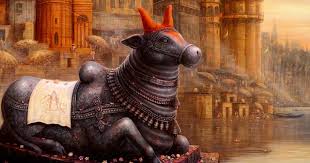
NANDI: THE DIVINE BULL OF LORD SHIVA
Nandi, the revered bull vahana (“mount”) of the Hindu god Shiva, has been identified as Shiva’s vehicle since the Kushan dynasty, around the 1st century CE. As we approach Sawan Shivratri, it is essential to delve into the significance of Nandi, whose presence is central to Shaivite worship.
In most Shaivite temples, you will find the figure of a humped white bull reclining on a raised platform, facing the entrance of the shrine, perpetually gazing upon Shiva. This posture symbolizes Nandi’s unwavering devotion and eternal vigilance. Nandi is not just a vehicle; he is one of Shiva’s chief attendants and is often depicted in sculpture as a bull-headed dwarf figure.
Iconography and Worship
Nandi is also known in a fully anthropomorphic form, variously called Nandikeshvara or Adhikaranandin. Sculptures of him in human form, found at the entrance doors of many South Indian Shaivite temples, are frequently confused with images of Shiva. This confusion arises due to shared iconographic features, such as the third eye, the crescent moon in the matted locks, and four arms—two of which hold a battle-axe and an antelope. A distinguishing feature of Nandi’s human form is his hands pressed together in adoration, showcasing his devout nature.

Cultural Significance and Modern Reverence
The respect shown to the bull in modern India is partly because of Nandi’s association with Shiva. During Sawan Shivratri, devotees pay special homage to Nandi, recognizing his role as the guardian and devotee of Lord Shiva. In Hindu cities such as Varanasi, certain bulls are given the freedom to roam the streets. These bulls are considered to belong to Shiva and are often branded on the flank with Shiva’s trident insignia, marking them as sacred.
Nandi’s influence extends beyond temples and festivals. His imagery can be found on various devotional items, including clothing. Devotees often wear t-shirts adorned with depictions of Nandi, as well as other Hindu deities, to express their faith. Popular designs include Hanuman t-shirts, Ganesh t-shirts, Krishna t-shirts, and Ganpati t-shirts. These items are not just fashion statements but expressions of devotion, much like Nandi’s perpetual gaze upon Shiva.
Nandi and Devotional Attire
As we celebrate Sawan Shivratri, wearing devotional attire can be a way to honor Nandi and the divine energies he represents. From an Anjaneya t-shirt (Hanuman) to a Krsna t-shirt (Lord Krishna), or even a t-shirt featuring Krishna’s playful and divine acts, these garments symbolize the wearer’s reverence and spiritual connection. Wearing a Hindu t-shirt with images of beloved deities like Lord Krishna not only displays devotion but also spreads awareness of the rich cultural heritage associated with these divine figures.
In summary, Nandi, the divine bull of Lord Shiva, holds a special place in Hindu worship, especially during significant festivals like Sawan Shivratri. To buy a variety of hindu t shirts like shivji t shirt, hanuman t shirt, ganesh t shirt, Krishna t shirt, ram t shirt, bajrang bali t shirt etc. click here! His perpetual devotion is a reminder of the unwavering faith and reverence that devotees can aspire to. Whether through temple visits or wearing devotional attire, honoring Nandi and the gods he serves continues to be a meaningful practice for many.
[The images used in this blog post are not owned by Anime Devta, they are just for entertainment purposes]
| SAWAN SHIVRATRI | LORD SHIVA | HINDU T SHIRT | SHIVJI T SHIRT | HANUMAN T SHIRT | GANESH T SHIRT | KRISHNA T SHIRT | RAM T SHIRT | BAJRANG BALI T SHIRT | HINDU |
~Mimansa Sharma

